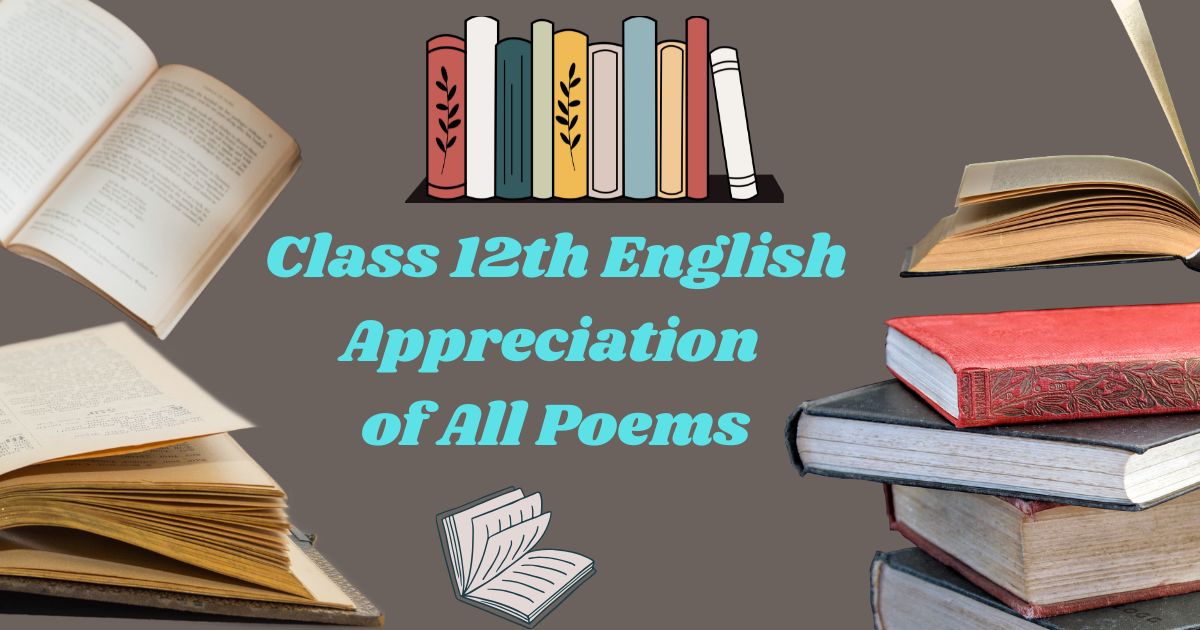Mastering class 12th English appreciation of all poems requires understanding diverse literary techniques, cultural contexts, and thematic elements. You’ll encounter works from renowned poets spanning different eras and backgrounds, each offering unique perspectives on human experiences. This comprehensive guide provides detailed analysis to help American students excel in their English literature studies.
On Killing a Tree by Gieve Patel
“It takes much time to kill a tree,
Not a simple jab of the knife
Will do it. It has grown
Slowly consuming the earth”
Gieve Patel’s environmental masterpiece explores humanity’s destructive relationship with nature. The poem uses extended metaphor to compare tree destruction with murder, emphasizing the deliberate cruelty required for complete annihilation.
Patel methodically describes the killing process, beginning with superficial wounds that merely “miniature boughs” can heal. The tree’s resilience becomes apparent through imagery of regeneration – bleeding bark and sprouting shoots symbolize nature’s determination to survive. However, the poet reveals the fatal technique: uprooting exposes the “white and wet” core, the tree’s vulnerable essence.
The irony lies in describing natural destruction as requiring patience and planning, paralleling human environmental destruction. Patel’s deliberate pacing mirrors the slow violence against ecosystems. The poem’s clinical tone creates disturbing detachment, forcing readers to confront their complicity in environmental degradation.
Contemporary relevance emerges through climate change discourse. Patel anticipates modern environmental concerns, making this poem particularly significant for class 12th English poetry appreciation studies focusing on ecological themes.
A Photograph by Shirley Toulson
“The cardboard shows me how it was
When the two girl cousins went paddling,
Each one holding one of my mother’s hands,
And she the big girl — some twelve years or so.”
Toulson’s poignant meditation on memory and mortality captures the bittersweet nature of photographic remembrance. The nostalgic tone immediately establishes emotional intimacy between speaker and reader.
The photograph becomes a temporal bridge connecting past and present. Toulson describes her mother’s childhood seaside holiday, frozen in black-and-white permanence. The “cardboard” reference emphasizes photography’s physical fragility, mirroring human mortality themes.
Generational perspective creates layered meaning. The speaker reflects on her mother’s youth while simultaneously mourning her mother’s death. This dual temporality – past happiness contrasted with present loss – generates profound emotional resonance.
Toulson employs circular structure, beginning and ending with silence. The final lines – “of this circumstance there is nothing to say at all” – acknowledge grief’s ineffability. Language fails when confronting mortality’s finality, making silence the most honest response.
The poem’s accessibility makes it perfect for class 12th English appreciation exercises focusing on personal narrative and universal themes of loss.
The Laburnum Top by Ted Hughes
“The Laburnum top is silent, quite still
In the afternoon yellow September sun,
A few leaves yellowing, all its seeds fallen.
Till the goldfinch comes.”
Hughes masterfully captures nature’s sudden transformation through the goldfinch’s arrival. The poem begins with static imagery – silence, stillness, emptiness – creating dramatic contrast with explosive life that follows.
The goldfinch becomes nature’s catalyst, transforming the dying tree into vibrant activity. Hughes uses onomatopoeia (“chittering,” “tremor”) to convey auditory chaos contrasting initial silence. The bird’s arrival triggers synesthetic experience – visual, auditory, and kinesthetic sensations merge.
Symbolism operates on multiple levels. The laburnum represents dormant potential, while the goldfinch embodies life force. Their interaction suggests symbiotic relationships throughout nature. The tree provides shelter; the bird provides energy and purpose.
Hughes’ precise observation reflects his reputation as nature poet. Details like “sleek as a lizard” and “alert, abrupt” demonstrate careful attention to wildlife behavior. This scientific accuracy combined with poetic sensibility makes the poem educationally valuable.
The cyclical structure – beginning and ending with silence – emphasizes nature’s rhythmic patterns, making this essential reading for class 12th English poetry appreciation curricula.
More Posts:25+ Heartwarming Children’s Day Poems from Teachers
The Voice of the Rain by Walt Whitman
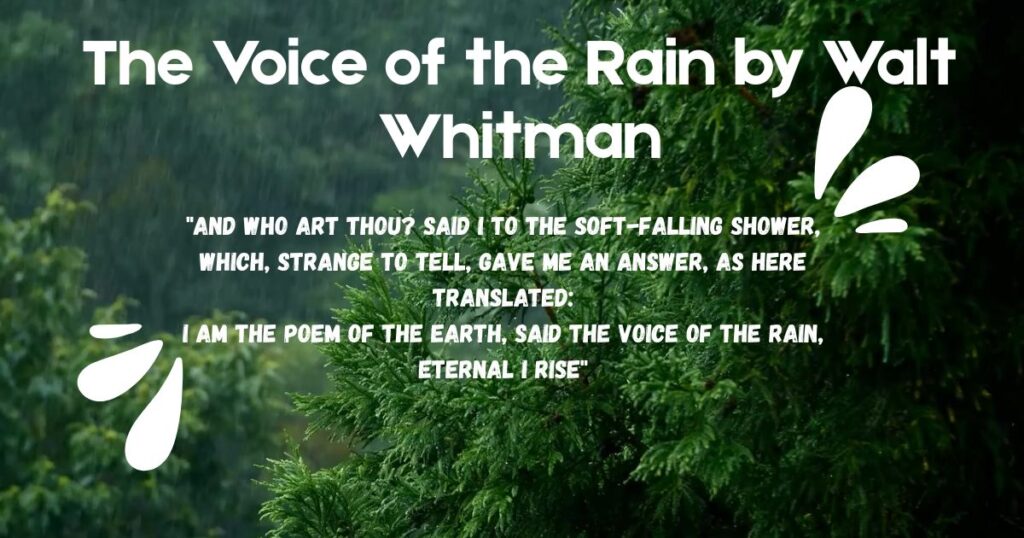
“And who art thou? said I to the soft-falling shower,
Which, strange to tell, gave me an answer, as here translated:
I am the poem of the earth, said the voice of the rain,
Eternal I rise”
Whitman’s personification of rain creates philosophical dialogue about creativity and renewal. The rain speaks directly, claiming identity as “poem of the earth,” establishing connections between natural processes and artistic creation.
The water cycle becomes metaphor for artistic inspiration. Rain rises as vapor, transforms in clouds, then returns “to lave the drouths, atomies, dust-layers of the globe.” This circular journey parallels creative process – inspiration rises from experience, transforms through imagination, returns enriched to nourish human understanding.
Free verse structure mirrors rain’s natural flow, rejecting traditional poetic constraints. Whitman’s characteristic cataloguing style appears in phrases like “drouths, atomies, dust-layers,” creating rhythmic abundance reflecting rain’s generous nature.
The poem’s democratic vision emerges through rain’s universal beneficence. Rain serves all equally – “latent, unborn” and “impalpable” alike. This egalitarian imagery reflects Whitman’s broader social philosophy.
Contemporary environmental consciousness finds resonance in Whitman’s ecological awareness. Rain’s voice celebrates natural cycles essential for planetary health, making this poem particularly relevant for modern class 12th English appreciation studies.
Childhood by Markus Natten
“When did my childhood go?
Was it the day I ceased to be eleven,
Was it the time I realised that Hell and Heaven,
Could not be found in Geography?”
Natten explores the liminal space between innocence and experience through questioning childhood’s end. The rhetorical questions create introspective tone, inviting readers to examine their own transitions to adulthood.
The poem identifies specific loss markers: religious doubt, recognizing adult hypocrisy, understanding love’s complexity, and gaining self-awareness. Each stanza presents potential childhood endpoints, suggesting transition occurs gradually rather than suddenly.
Metaphorical geography appears throughout – Hell and Heaven missing from atlases, mind’s hidden places. Natten uses spatial imagery to represent psychological development. Childhood becomes unmappable territory, lost through knowledge acquisition.
The mirror motif in the final stanza provides resolution. Self-recognition marks definitive childhood end – seeing oneself as separate individual rather than undifferentiated being. The mirror reflects psychological maturation, showing adult identity emerging.
Natten’s accessible language makes complex psychological concepts understandable for young readers, making this poem valuable for class 12th English poetry appreciation focusing on coming-of-age themes.
The Adventure by Jayant Narlikar
“Professor Gaitonde was the historian’s historian.
If the Marathas had won the battle of Panipat,
how would India be different today?
This question had bothered him for years.”
Narlikar blends historical speculation with scientific theory in this prose-poem exploring alternate history. The narrative follows Professor Gaitonde’s journey through parallel universes where historical events unfolded differently.
Quantum mechanics provides the theoretical framework. The story explores many-worlds interpretation – infinite parallel realities existing simultaneously. Gaitonde’s accident creates dimensional shift, allowing him to experience alternate timeline where Marathas defeated Ahmad Shah Abdali.
The historical what-if scenario examines how single events reshape civilizations. In Gaitonde’s alternate world, Indian independence occurs differently, creating entirely different political landscape. This counterfactual history encourages critical thinking about causation and consequence.
Narrative technique combines realistic detail with fantastical premise. Narlikar grounds speculative elements in scientific plausibility, making extraordinary events seem credible. The first-person perspective creates immediacy and authenticity.
The story’s educational value lies in encouraging students to think critically about history’s contingent nature, making it excellent material for class 12th English appreciation exercises combining literature with historical analysis.
More Posts:25+ Broken Heart Poems That Make You Cry
Silk Road by Nick Middleton
“The sky was overcast and there was a chill in the air.
At 5:30 am the sun was not yet up.
But we could see the massive form of Mount Kailash
emerging from the mist in the distance.”
Middleton’s travelogue narrative captures the spiritual and physical challenges of journeying to Mount Kailash. The prose combines geographical documentation with personal reflection, creating immersive reading experience.
Sacred geography dominates the narrative. Mount Kailash represents spiritual pinnacle for multiple religions – Hindu, Buddhist, Jain, and Bon traditions consider it sacred. Middleton approaches this religious significance with appropriate reverence while maintaining journalistic objectivity.
The harsh landscape becomes character itself. Tibetan plateau’s extreme conditions – altitude sickness, bitter cold, treacherous terrain – test travelers’ physical and mental endurance. Middleton’s detailed descriptions help readers experience environmental challenges vicariously.
Cultural encounters provide narrative richness. Interactions with Tibetan people, Chinese officials, and fellow pilgrims reveal complex geopolitical realities underlying spiritual journeys. The author navigates cultural sensitivity while documenting authentic experiences.
The narrative’s contemplative pace mirrors the meditative nature of pilgrimage itself, making this text valuable for class 12th English poetry appreciation studies focusing on travel literature and spiritual themes.
Father to Son by Elizabeth Jennings
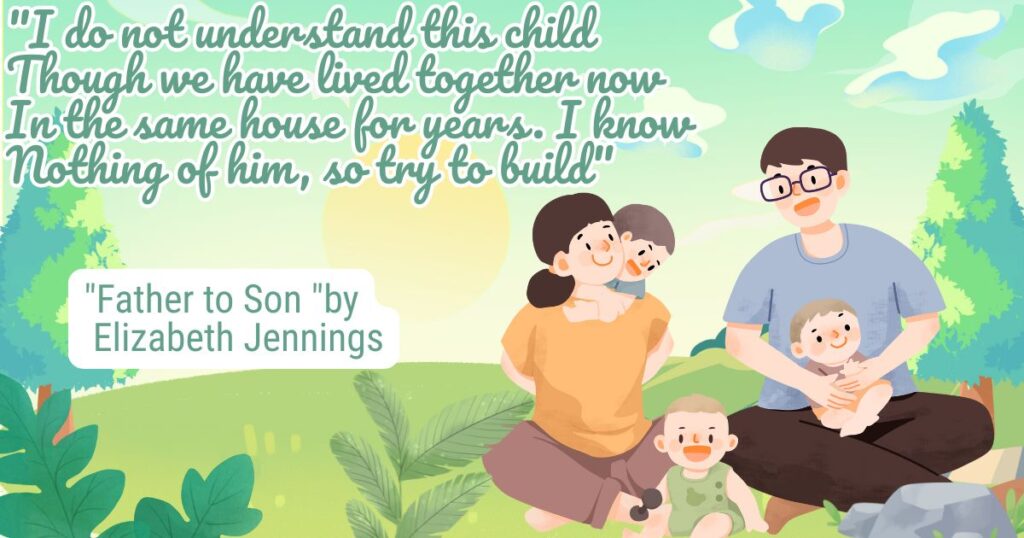
“I do not understand this child
Though we have lived together now
In the same house for years. I know
Nothing of him, so try to build”
Jennings explores the generational disconnect between father and son with remarkable emotional honesty. The poem addresses universal parenting struggles – understanding, communication, and acceptance across generational divides.
Architectural metaphors permeate the text. The father attempts to “build” relationship bridges, but efforts prove futile. The building imagery suggests relationships require careful construction, yet also implies potential for collapse when foundations prove unstable.
Internal conflict drives the poem’s emotional power. The father simultaneously expresses love and frustration, pride and disappointment. This psychological complexity avoids simplistic resolution, reflecting real family dynamics’ messiness.
The two-voice structure – father speaking about son, then addressing him directly – creates dramatic tension. Shift from third-person description to second-person address intensifies emotional urgency and desperation.
Jennings’ accessible language masks sophisticated emotional depth, making complex family dynamics comprehensible for young readers studying class 12th English appreciation themes of family relationships and communication.
We Too Are Human by Deming Ware
“We too are human beings,
We too have feelings and emotions,
We too can laugh and cry,
We too deserve respect and dignity.”
Ware’s civil rights anthem demands recognition of shared humanity across racial divisions. The repetitive structure (“We too”) creates powerful rhetorical emphasis, challenging discriminatory assumptions through insistent declaration of equal humanity.
Universal human experiences form the poem’s foundation. Ware catalogs emotions, aspirations, and needs common to all people regardless of race. This inclusive vision counters dehumanizing prejudices by emphasizing fundamental similarities.
The poem’s historical context emerges from America’s civil rights movement. Written during era of systematic segregation, Ware’s words carry urgent political significance. The simple language makes complex social justice concepts accessible to broad audiences.
Parallel structure creates rhythmic power building to emotional climax. Each stanza adds weight to the central argument, creating cumulative effect that overwhelms opposition through sheer insistence on truth.
The poem’s timeless relevance extends beyond its historical moment, addressing ongoing struggles for social justice and human dignity, making it valuable for class 12th English poetry appreciation focusing on social consciousness.
More Posts:25+ Heartfelt Birthday Poems for Daughter from Mother
The Ghat of the Only World by Amitav Ghosh
“The word ‘ghat’ has no real equivalent in English;
it refers to the broad stone steps that lead down
to the water in every Indian city.
But it means much more than that.”
Ghosh’s cultural meditation explores the ghat as symbol of Indian spiritual and social life. The essay combines anthropological observation with personal reflection, creating rich tapestry of meaning around this architectural form.
Symbolic significance transcends mere physical description. Ghats represent liminal spaces where life and death intersect, where sacred and secular merge. Ghosh explores how these threshold spaces facilitate spiritual transformation and community gathering.
Historical depth enriches the narrative. Ghosh traces ghats’ evolution through centuries of Indian civilization, showing how these spaces adapted to changing social needs while maintaining essential spiritual functions. This temporal perspective adds gravitas to contemporary observations.
The author’s personal connection to ghats emerges through family memories and individual experiences. These autobiographical elements ground abstract cultural analysis in lived experience, making theoretical concepts emotionally resonant.
Ghosh’s lyrical prose elevates documentary writing to literary art, making this text excellent for class 12th English appreciation studies combining cultural studies with literary analysis.
Birth by A.J. Cronin
“It was past midnight when Andrew Davidson
left the house of Joe Morgan, the miner,
and walked slowly up the hill to his lodgings.
Behind him the Drineffy pit-head showed”
Cronin’s medical drama follows young doctor Andrew Davidson through a difficult delivery, exploring themes of professional dedication and human compassion. The narrative combines realistic medical detail with emotional depth.
Working-class setting provides authentic social context. Cronin, himself a physician, draws from experience treating mining communities. The industrial landscape – pit-heads, miners’ cottages, harsh living conditions – creates compelling backdrop for human drama.
Professional crisis drives the plot. Davidson faces moment where textbook knowledge proves insufficient, requiring innovative thinking and moral courage. The life-or-death situation tests character under extreme pressure.
The birth metaphor operates on multiple levels. Beyond literal childbirth, the story depicts Davidson’s professional rebirth – transformation from uncertain student to confident physician. The dual birth narrative creates thematic richness.
Cronin’s accessible prose makes complex medical and ethical issues comprehensible for general readers, making this story valuable for class 12th English poetry appreciation studies focusing on professional ethics and social responsibility.
The Tale of Melon City by Vikram Seth
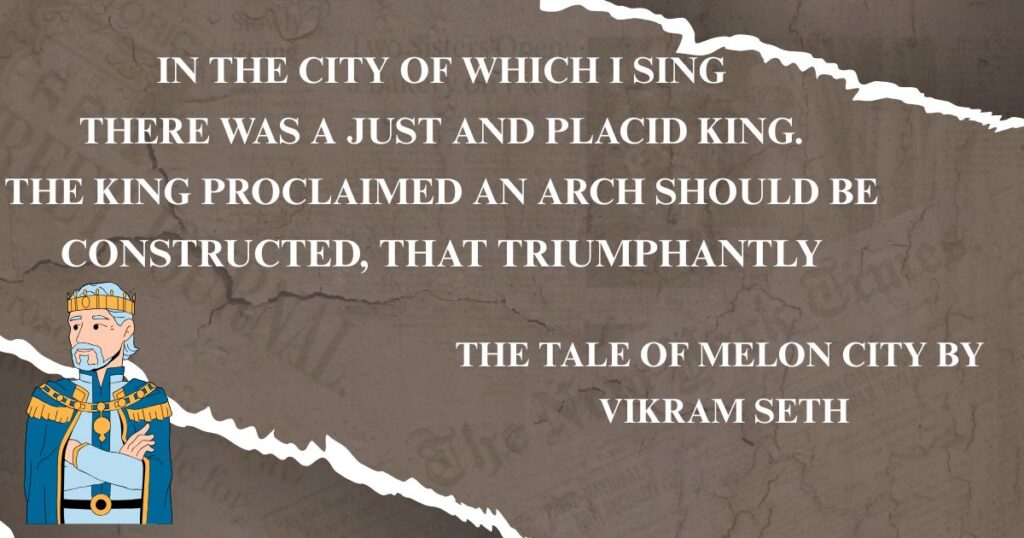
“In the city of which I sing
There was a just and placid King.
The King proclaimed an arch should be
Constructed, that triumphantly”
Seth’s satirical verse tale lampoons bureaucratic absurdity and arbitrary governance through darkly comic narrative. The mock-heroic style creates humorous contrast between trivial events and epic treatment.
Absurdist logic drives the plot forward. Each decision leads to increasingly ridiculous consequences, culminating in a melon becoming king. This reductio ad absurdum technique exposes governmental irrationality through exaggeration.
Social satire targets multiple institutions. Seth mocks judicial systems, royal authority, architectural pretensions, and mob mentality. The comprehensive critique reveals how systematic incompetence pervades hierarchical societies.
Narrative voice maintains deadpan tone throughout escalating chaos. The matter-of-fact delivery of outrageous events creates comic incongruity, forcing readers to question their own acceptance of institutional authority.
The poem’s political allegory resonates across cultures and time periods, making it excellent material for class 12th English appreciation studies exploring political satire and social criticism.
More Posts:30+ Best Poems for English Recitation Competition
The Browning Version by Terence Rattigan
“Millie Crocker-Harris was about forty-four,
rather more smartly dressed than
the general run of schoolmasters’ wives.
She had faded blonde hair”
Rattigan’s psychological drama explores marital breakdown and professional failure through the character of Andrew Crocker-Harris, a classics teacher facing retirement. The realistic dialogue and detailed characterization create compelling human portrait.
Academic setting provides rich dramatic context. The British public school environment – with its traditions, hierarchies, and repressed emotions – becomes microcosm for broader social conventions. Rattigan expertly navigates this institutional framework.
Character relationships drive emotional conflict. The triangular tension between Crocker-Harris, his wife Millie, and younger colleague Frank Hunter creates dramatic complexity. Each character represents different responses to personal dissatisfaction.
Classical allusions add thematic depth. The Browning version – Agamemnon translation – becomes central metaphor for betrayal and tragic recognition. The parallel structure between ancient and modern stories enriches dramatic meaning.
Rattigan’s subtle psychology avoids melodrama while maintaining emotional intensity, making this play excellent for class 12th English poetry appreciation focusing on dramatic literature and character analysis.
Mother’s Day by J.B. Priestley
“MRS. FITZGERALD: Well, I don’t know what
you two have been plotting together,
but I can tell you this much —
I’m not having it!”
Priestley’s domestic comedy examines gender roles and family dynamics through role-reversal scenario. When women demand recognition for their labor, traditional household structures collapse into chaos.
Social critique underlies comic situations. Priestley exposes how unpaid domestic work sustains family life while remaining invisible and unappreciated. The feminist themes emerge through exaggerated situations revealing serious inequities.
Character types represent broader social categories. Mrs. Pearson embodies submissive housewife, while Mrs. Fitzgerald represents liberated woman. Their personality exchange creates opportunities for social commentary through comic contrast.
Theatrical techniques maximize comedic impact. Mistaken identities, physical comedy, and rapid-fire dialogue create entertaining spectacle while delivering pointed social criticism. The farcical elements make serious themes accessible.
The play’s enduring relevance to ongoing discussions about work-life balance and gender equality makes it valuable for class 12th English appreciation studies exploring social issues through dramatic literature.
Albert Einstein at School by Patrick Pringle
“Albert Einstein was born at Ulm in Germany
on March 14, 1879. When he was a year old,
his family moved to Munich, where his father
established an electrical engineering business”
Pringle’s biographical narrative explores Einstein’s unconventional educational experience, challenging traditional schooling methods through the genius’s struggles with institutional learning.
Educational critique forms the story’s core. Einstein’s conflicts with authoritarian teachers and rigid curricula illustrate how conventional education can stifle creativity and independent thinking. The narrative champions alternative learning approaches.
Character development shows Einstein’s evolution from frustrated student to confident individual. His intellectual curiosity conflicts with institutional expectations, creating dramatic tension between personal growth and social conformity.
Historical context enriches the narrative. Late 19th-century German education system – emphasizing rote learning and strict discipline – provides backdrop for Einstein’s rebellion. This period detail helps readers understand cultural constraints on intellectual development.
The story’s inspirational message about overcoming institutional limitations makes it valuable for class 12th English poetry appreciation studies focusing on education themes and biographical literature.
Ranga’s Marriage by Masti Venkatesha Iyengar
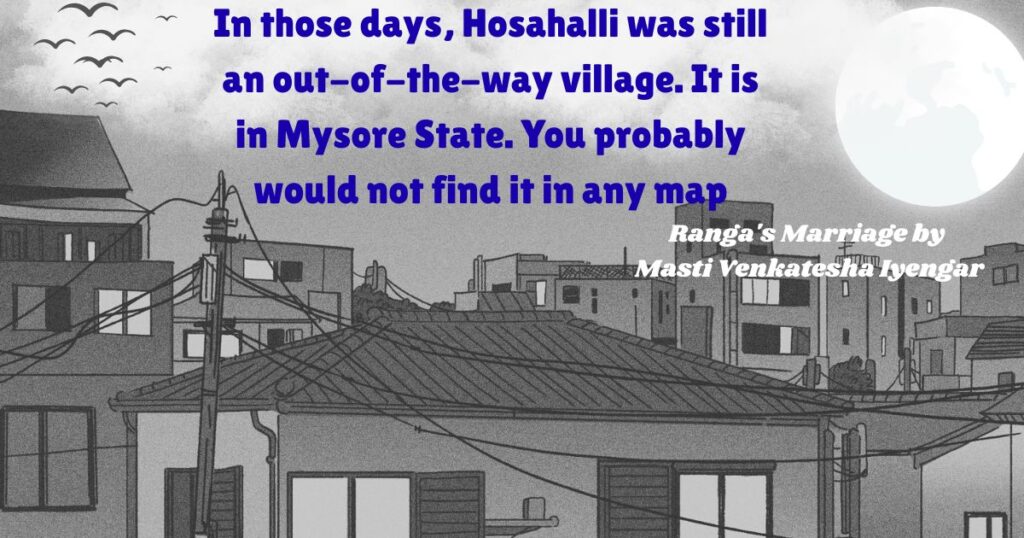
“In those days, Hosahalli was still
an out-of-the-way village. It is
in Mysore State. You probably
would not find it in any map.”
Iyengar’s regional narrative captures traditional South Indian village life through the story of Ranga’s arranged marriage. The first-person narration creates intimate community perspective.
Cultural documentation preserves vanishing rural traditions. Iyengar details marriage customs, caste considerations, and community involvement in personal decisions. This ethnographic value makes the story historically significant.
Generational conflict emerges through Ranga’s Western education versus traditional expectations. His urban exposure creates tension with village values, reflecting broader cultural changes in colonial India.
Narrative technique combines folk storytelling with literary sophistication. The narrator’s conversational tone and direct address to readers creates sense of oral tradition while maintaining literary quality.
The story’s humor and human warmth make serious cultural themes accessible, providing excellent material for class 12th English appreciation studies exploring regional literature and cultural preservation.
The Portrait of a Lady by Khushwant Singh
“My grandmother, like everybody’s grandmother,
was an old woman. She had been old
and wrinkled for the twenty years
that I had known her.”
Singh’s autobiographical narrative creates moving portrait of his grandmother, exploring themes of aging, tradition, and intergenerational love. The circular structure mirrors life’s cyclical nature.
Character portrayal transcends mere description. The grandmother emerges as fully realized individual with complex personality – religious devotion, fierce independence, deep affection, and quiet strength. Singh avoids sentimental idealization.
Cultural transitions provide thematic foundation. The narrative traces family’s movement from traditional village to modern city, showing how social changes affect personal relationships and cultural practices.
Symbolic elements enrich the narrative. The grandmother’s feeding sparrows, spinning wheel, and prayer routines become metaphors for continuity, tradition, and spiritual connection across changing circumstances.
Singh’s precise prose and emotional restraint create powerful impact without melodrama, making this story excellent for class 12th English poetry appreciation focusing on family relationships and cultural change.
More Posts:The 30+ Best Hindi Poems of All Time: A Journey Through India’s Literary Soul
We’re Not Afraid to Die… If We Can All Be Together by Gordon Cook and Alan East
“In July 1976, my wife Mary, son Jonathan, 6,
daughter Suzanne, 7, and I set sail from Plymouth, England,
to duplicate the round-the-world voyage made
200 years earlier by Captain James Cook.”
Cook and East’s survival narrative chronicles a family’s harrowing ocean voyage, combining adventure storytelling with family drama. The first-person perspective creates immediate emotional connection.
Natural conflict drives dramatic tension. The hostile ocean environment becomes primary antagonist, testing family bonds under extreme survival conditions. Descriptive writing makes readers experience the danger vicariously.
Family dynamics under pressure reveal character depths. Parents’ protective instincts, children’s resilience, and collective determination create inspiring human portrait. The survival situation strips away social conventions to reveal essential humanity.
Technical detail adds authenticity to adventure narrative. Sailing terminology, weather descriptions, and navigation challenges provide realistic framework for extraordinary events. This documentary precision enhances credibility.
The story’s universal themes of family loyalty and human endurance make it accessible across cultures, providing excellent material for class 12th English appreciation studies focusing on adventure literature and family bonds.
Discovering Tut: The Saga Continues by A.R. Williams
“King Tut is one of the first mummies
to be scanned — in death, as in life,
moving along with the times.
The mummy was scanned”
Williams combines archaeological science with historical mystery in examining Tutankhamun’s mummy through modern technology. The narrative bridges ancient history and contemporary research.
Scientific methodology provides analytical framework. The CT scanning process reveals previously hidden details about the pharaoh’s life and death, demonstrating how modern technology illuminates historical mysteries.
Historical significance emerges through detailed analysis. Tutankhamun’s brief reign and mysterious death continue fascinating researchers and public alike. Williams explains why this minor pharaoh achieved major cultural impact.
Archaeological ethics underlies scientific investigation. The narrative addresses tensions between scientific curiosity and cultural respect, showing how researchers balance knowledge acquisition with preservation responsibilities.
The combination of scientific content with narrative storytelling makes complex archaeological research accessible, providing valuable material for class 12th English poetry appreciation studies combining science and literature.
The Summer of the Beautiful White Horse by William Saroyan
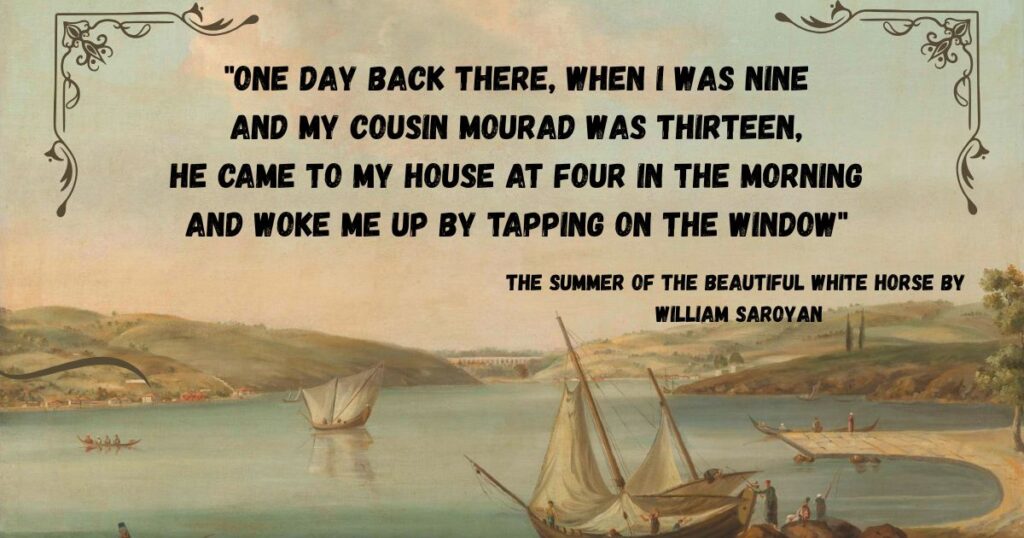
“One day back there, when I was nine
and my cousin Mourad was thirteen,
he came to my house at four in the morning
and woke me up by tapping on the window”
Saroyan’s nostalgic narrative captures childhood adventure through the story of two Armenian-American boys and their temporary “borrowing” of a white horse. The first-person retrospective creates bittersweet tone.
Cultural identity provides rich background. The Armenian immigrant community maintains distinct traditions while adapting to American life. Saroyan explores how ethnic heritage shapes family values and personal identity.
Moral complexity avoids simple right-wrong distinctions. The boys’ horse “borrowing” raises questions about property, justice, and cultural values. Their actions violate law while upholding family honor.
Coming-of-age themes emerge through moral decision-making. The protagonist faces conflicts between desire and conscience, adventure and responsibility. These ethical dilemmas reflect universal adolescent experiences.
Saroyan’s lyrical prose and gentle humor create accessible narrative exploring serious themes, making this story excellent for class 12th English appreciation studies focusing on cultural identity and moral development.
Landscape of the Soul by Nathalie Trouveroy
“The Emperor was an art lover
and had commissioned many paintings.
He was having difficulty in choosing
between the two paintings”
Trouveroy’s philosophical essay explores different artistic traditions through contrasting Chinese and European approaches to landscape painting. The narrative examines how cultural perspectives shape artistic expression.
Aesthetic philosophy provides analytical framework. Trouveroy contrasts Western representational techniques with Eastern spiritual approaches, showing how cultural values influence artistic methods and interpretive frameworks.
Cross-cultural analysis reveals fundamental differences in worldview. Chinese artists seek spiritual essence while European painters emphasize physical accuracy. These aesthetic preferences reflect broader philosophical traditions.
Artistic examples illustrate theoretical concepts. Specific paintings and techniques provide concrete evidence for abstract arguments about cultural differences in artistic representation and spiritual expression.
The essay’s accessible style makes complex aesthetic theory understandable for general readers, providing excellent material for class 12th English poetry appreciation studies combining art criticism with cultural analysis.
More Posts:Where Can I Publish My Poems / Your Poetry Published in 2025
The Ailing Planet: The Green Movement’s Role by Nani Palkhivala
“The population of the world reached
one billion by 1800, but it took
only 130 years more to add
the second billion.”
Palkhivala’s environmental essay examines ecological crisis and proposes solutions through green movement activism. The analytical approach combines scientific data with moral urgency.
Environmental statistics provide sobering context. Population growth, resource depletion, and pollution data create compelling case for immediate action. Palkhivala uses quantitative evidence to support qualitative arguments.
Systemic analysis reveals interconnected problems. Economic systems, political structures, and individual behaviors all contribute to environmental degradation. The essay demonstrates how complex systems require comprehensive solutions.
Green movement strategies offer hope for planetary healing. Palkhivala outlines specific conservation methods, policy changes, and lifestyle modifications that could address environmental challenges effectively.
The essay’s urgent tone and practical solutions make environmental issues compelling for young readers, providing valuable material for class 12th English appreciation studies focusing on environmental consciousness and social responsibility.
Conclusion
Mastering class 12th English appreciation of all poems requires understanding diverse literary techniques, cultural contexts, and universal themes that connect human experiences across time and geography. These carefully selected works provide comprehensive foundation for developing critical thinking skills and literary sensitivity. Through detailed analysis and thoughtful engagement, you’ll gain deeper appreciation for poetry’s power to illuminate human condition and inspire meaningful reflection.

Admin of https://aspirenowa.com/. Sharing Touching and Thoughtful Poems for all Hearts. I Believe in Simple Words, Deep Meaning, and Inspiring Emotions through Poetry for Every Reader.
